
Very low frequency or VLF is the ITU designation for radio frequencies (RF) in the range of 3–30 kHz, corresponding to wavelengths from 100 to 10 km, respectively. The band is also known as the myriameter band or myriameter wave as the wavelengths range from one to ten myriameters. Due to its limited bandwidth, audio (voice) transmission is highly impractical in this band, and therefore only low data rate coded signals are used. The VLF band is used for a few radio navigation services, government time radio stations and for secure military communication. Since VLF waves can penetrate at least 40 meters (131 ft) into saltwater, they are used for military communication with submarines.

High frequency (HF) is the ITU designation for the range of radio frequency electromagnetic waves between 3 and 30 megahertz (MHz). It is also known as the decameter band or decameter wave as its wavelengths range from one to ten decameters. Frequencies immediately below HF are denoted medium frequency (MF), while the next band of higher frequencies is known as the very high frequency (VHF) band. The HF band is a major part of the shortwave band of frequencies, so communication at these frequencies is often called shortwave radio. Because radio waves in this band can be reflected back to Earth by the ionosphere layer in the atmosphere – a method known as "skip" or "skywave" propagation – these frequencies are suitable for long-distance communication across intercontinental distances and for mountainous terrains which prevent line-of-sight communications. The band is used by international shortwave broadcasting stations (3.95–25.82 MHz), aviation communication, government time stations, weather stations, amateur radio and citizens band services, among other uses.

Royal Air Force Kinloss or RAF Kinloss is a former Royal Air Force (RAF) station located near the village of Kinloss, on the Moray Firth in the north east of Scotland.
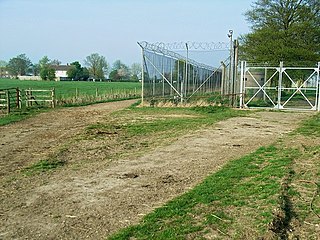
Royal Air Force Bampton Castle or RAF Bampton Castle is a former non-flying Royal Air Force station near Bampton Castle, Oxfordshire.
Communication with submarines is a field within military communications that presents technical challenges and requires specialized technology. Because radio waves do not travel well through good electrical conductors like salt water, submerged submarines are cut off from radio communication with their command authorities at ordinary radio frequencies. Submarines can surface and raise an antenna above the sea level, or float a tethered buoy carrying an antenna, then use ordinary radio transmissions, however this makes them vulnerable to detection by anti-submarine warfare forces. Early submarines during World War II mostly traveled on the surface because of their limited underwater speed and endurance, and dove mainly to evade immediate threats or for stealthy approach to their targets. During the Cold War, however, nuclear-powered submarines were developed that could stay submerged for months. In the event of a nuclear war, submerged ballistic missile submarines have to be ordered quickly to launch their missiles. Transmitting messages to these submarines is an active area of research. Very low frequency (VLF) radio waves can penetrate seawater a few hundred feet (10–40 meters), and many navies use powerful shore VLF transmitters for submarine communications. A few nations have built transmitters which use extremely low frequency (ELF) radio waves, which can penetrate seawater to reach submarines at operating depths, but these require huge antennas. Other techniques that have been used include sonar and blue lasers.

Rugby Radio Station was a large radio transmission facility just east of the Hillmorton area of the town of Rugby, Warwickshire in England. The site straddled the A5 trunk road, with most of it in Warwickshire, and part on the other side of the A5 in Northamptonshire. First opened in 1926, at its height in the 1950s it was the largest radio transmitting station in the world, with a total of 57 radio transmitters, covering an area of 1,600 acres (650 ha). Traffic slowly dwindled from the 1980s onwards, and the site was closed between 2003 and 2007.
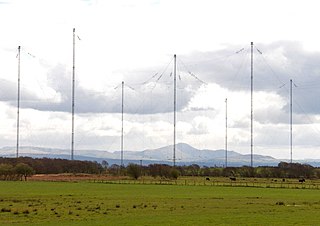
Anthorn Radio Station is a naval and government radio transmitting station located near Anthorn, Cumbria, England, overlooking the Solway Firth, and is operated by Babcock International. It has three transmitters: one VLF; one LF; and an eLORAN transmitter.

HMS Forest Moor was a Royal Navy land base located in Nidderdale in the borough of Harrogate, North Yorkshire, England.
VT Communications was a part of VT Group plc. VT Communications was essentially the company formed from the privatisation of the BBC World Service transmitter sites. It was initially named Merlin Communications, then, after acquisition by VT, VT Merlin Communications. It provided transmission services to over 20 different customers from four main sites in the UK and many others in the rest of the world.
The High Frequency Global Communications System (HFGCS) is a network of single sideband shortwave transmitters of the United States Air Force which is used to communicate with aircraft in flight, ground stations and some United States Navy surface assets. All worldwide receiving and transmitting sites in the HFGCS system are remotely controlled from Andrews Air Force Base and Grand Forks Air Force Base. Before 1 October 2002 it was known as the Global High Frequency System (GHFS).
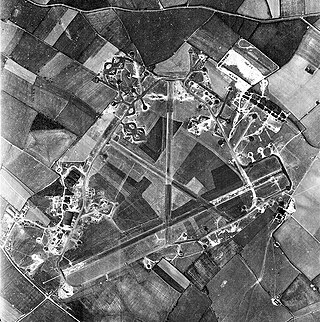
Royal Air Force Chelveston, or more simply RAF Chelveston, is a former Royal Air Force station located on the south side of the B645, 5 miles (8.0 km) east of Wellingborough, near the village of Chelveston in Northamptonshire, England. During the Second World War the airfield was occupied by both the Royal Air Force and the United States Army Air Forces. It was given the USAAF designation Station 105.
Babcock International Group plc is a British aerospace, defence and nuclear engineering services company based in London, England. It specialises in managing complex assets and infrastructure. Although the company has civil contracts, its main business is with public bodies, particularly the United Kingdom's Ministry of Defence and Network Rail. The company has four operating sectors, with overseas operations based in Africa, North America, South America, Europe and Australia.

The Defence Communication Services Agency (DCSA) was an agency of the United Kingdom Ministry of Defence responsible for the procurement and delivery of Communications and Information Services (CIS) to the defence community and related public and private sector bodies. The Agency was formed on 1 April 1998, bringing together a range of CIS organisations across all three services.

Royal Air Force St. Eval or RAF St. Eval was a Royal Air Force station for the RAF Coastal Command, southwest of Padstow in Cornwall, England, UK. St Eval's primary role was to provide anti-submarine and anti-shipping patrols off the south west coast. Aircraft from the airfield were also used for photographic reconnaissance missions, meteorological flights, convoy patrols, air-sea rescue missions and protection of the airfield from the Luftwaffe.

RNAS Inskip, or as it was otherwise known HMS Nightjar, is a former Fleet Air Arm airfield near the village of Inskip, Lancashire, England at 53.827433°N 2.829537°W. In the 60's and 70's it was a Royal Navy transmitting station known as HMS INSKIP. It is now used as a military high frequency radio transmitting station.ow

Royal Navy Air Station Rattray or RNAS Rattray and also known as Crimond Airfield, Crimond Aerodrome or Rattray Aerodrome was a Royal Naval Air Station near Crimond, Aberdeenshire.
RAF Stanbridge was a non-flying RAF station situated on the outskirts of Leighton Buzzard, Bedfordshire, England and located 1.6 miles (2.6 km) west of the village of Stanbridge, Bedfordshire.
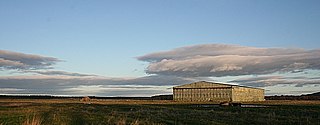
Royal Air Force Milltown or RAF Milltown is a former Royal Air Force station located south of the Moray Firth and 3.6 miles (5.8 km) north east of Elgin, Scotland.
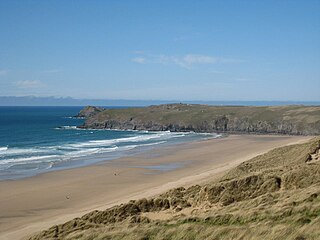
Penhale Sands, or Penhale Dunes, is a complex of sand dunes and a protected area for its wildlife, on the north Cornwall coast in England, UK. It is the most extensive system of sand dunes in Cornwall and is believed to be the landing site of Saint Piran. Dating from the 6th century, St Piran's Oratory is thought to be one of the oldest Christian sites in Britain. The remains were discovered in the late 18th century, and in 2014 the covering sand was removed to reveal a building more than a thousand years old, in a reasonable state of preservation. A restricted military area dating from 1939, Penhale Camp, is found on the northern part of the dunes.

Kinloss Barracks is a military installation located near the village of Kinloss, on the Moray Firth in the north of Scotland. Until 2012 it was a Royal Air Force (RAF) station, RAF Kinloss.

















